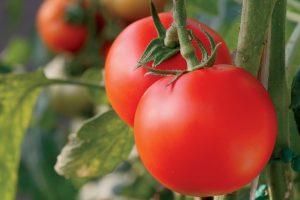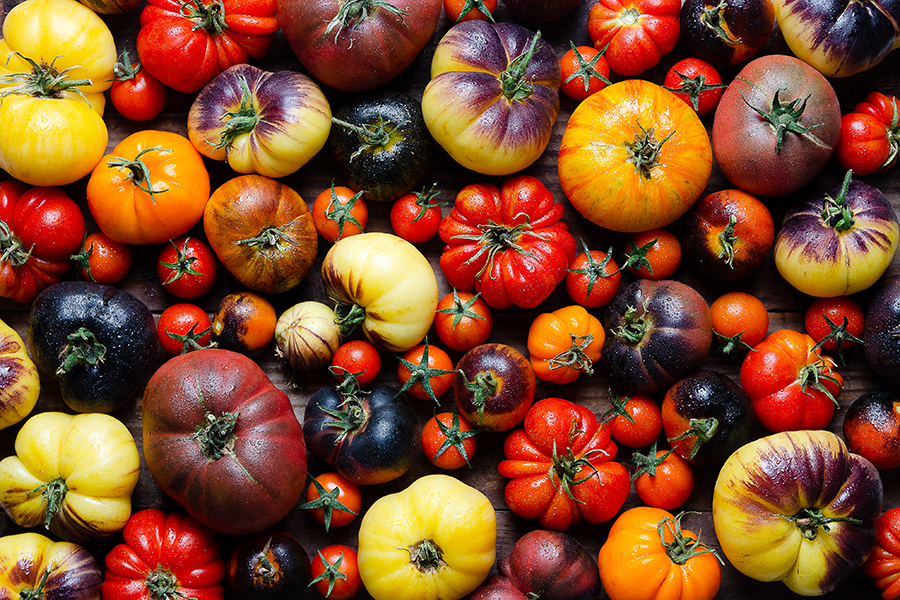Home > Lifestyle > Food For Thought > What’s the Difference Between Determinate and Indeterminate Tomatoes?
What’s the Difference Between Determinate and Indeterminate Tomatoes?
Tomatoes come in so many different sizes, shapes and colors. But most fall into two main categories when it comes to growth habits: determinate and indeterminate. What’s the difference between the two? Read on to find out.

Determinate Tomatoes
Determinate tomatoes are sometimes referred to as bush tomatoes, which may give you a good mental image of what to expect when you plant these varieties in the garden. They often reach heights of 4 feet or less, although some will continue growing up to 5 feet. You can tell when these tomato types have reached their full height when you spot flowers at the tips of their branches.
The most defining characteristic of determinate tomatoes is that they are going to produce almost all their fruit at once. This is an ideal trait for anyone who wants to preserve tomatoes for fall and winter since you can harvest all the fruit from the plant at the same time. The often short stature of these plants also makes them a great choice for gardeners who are short on space but still want to enjoy homegrown tomatoes.
You rarely need to stake determinate tomatoes since they don’t grow tall enough to require additional support. You can use cages if you find the plant growing more than 3 feet tall or producing heavier fruit than the stem can bear, or you can allow the plant to sprawl along the ground.
Avoid pruning the suckers on determinate tomatoes. Because they only produce one or two waves of fruit, pruning will reduce your yield.
See more: Complete Guide to Tomato Varieties and How to Use Them

Indeterminate Tomatoes
Indeterminate tomatoes are occasionally referred to as vining tomatoes. Many of the indeterminate varieties you see in home gardens reach heights of 6 to 8 feet, but there are some that will willingly grow to more than 15 feet if given the right support and growing conditions.
Unlike determinates, these vining tomatoes will produce fruit throughout the entire growing season until the first frost arrives. Anyone who wants to enjoy fresh slicing or snacking tomatoes throughout the season will benefit from planting indeterminate tomatoes since they will continue to produce fruit for months on end.
Be prepared to stake any indeterminate tomatoes you plant. Many of the classic beefsteak and large heirloom varieties fall into this category, and the weight of all the fruit can break the plant’s stem without the right support. Cages, trellises and stakes are all good options for supporting indeterminate tomatoes as they grow.
Pruning suckers from the lower section of indeterminate tomatoes will help increase airflow around the base of the plant, make them easier to trellis or cage, and improve the quality of the fruit produced throughout the season.
See more: What Are Green Tomatoes? (And How to Use Them in the Kitchen)
Semi-Determinate Tomatoes
There are exceptions to any rule, and tomatoe categories are no different. Semi-determinate tomatoes fall in between the lines of determinate and indeterminate, and they are less common than the primary two growing types.
Semi-determinate tomatoes are more compact than indeterminate tomatoes, resembling the determinate varieties, but will often produce fruit throughout the season. Many of these tomato types are technically indeterminate varieties with shorter vines, but some will produce large quantities in multiple spurts throughout the summer.
Understandably, that makes them hard to classify!
Depending on the height of your semi-determinate tomatoes, you may want to stake or cage them. Many gardeners enjoy using the Florida weave method for these growth types. Avoid pruning these too aggressively, too, since you may end up cutting your yield by removing too many suckers.
See more: How to Grow and Care for Tomato Plants



